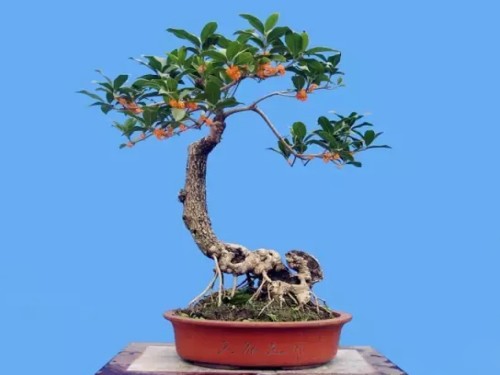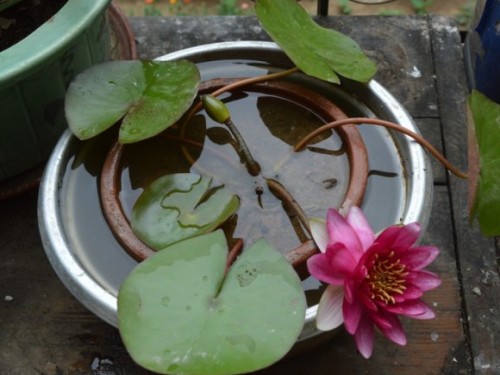Cultivation and Management of Golden Bean Bonsai
Jindou is native to the hilly areas of southern China. It grows slowly and is easy to shape. It is a good material in the hands of bonsai artists. Golden bean tree is strong in nature, and it is an ideal bonsai tree species for both leaf, stem and fruit appreciation. The ornamental value of the hanging fruit period is very high, and it is regarded as a precious bonsai in Japan. Golden beans are ornamental fruit plants, which can be planted in clusters, on the edge of the forest or around buildings, as well as potted plants and bonsai.
Golden beans can hang the fruit until May Day of the following year at the latest. If the fruit is too long, it will affect the growth of the following year. Generally around New Year's Day, artificial thinning of the fruit. The fruit of golden bean is sour and sweet and can be eaten after pickling white sugar. So, how to cultivate and manage bonsai with golden beans? Next, the editor will introduce to you.
1. Mountain mining time
It is better from the end of March to the beginning of May every year, when the survival rate of tree stump is the highest.
2. The method of raising billet
Use a very thin single layer of plastic film (such as cling film) to wrap the branches before planting. Cling film wrapping the trunk can achieve the purpose of moisturizing, in early May, when the new buds of golden beans occur, it can break the single-layer cling film. In cold years or more branched stumps, you can use multi-layer plastic wrap, but when the new buds of golden beans grow, you need to break the film manually. Jindou billet is made of plain soil, do not contain too much fertility, and it is better to use loose and breathable yellow mud.
3. Potting time
When the billet pile sends out new branches and leaves, it can be put on the pot as early as the second half of the year. If time permits, maintenance is generally required for more than 2 years. The most suitable time to change the basin is after Qingming Festival (April 5), and another more appropriate time is the end of August and the beginning of September.
4. Preparation of basin soil
The soil is required to be fertile, and some cake fertilizer and rotten leaf soil can be added appropriately.
5. the method of potting.
Golden beans can be brought to the soil, or they can be put on the pot with bare roots. When the bare root is in the basin, the overlong thick root can be properly truncated, which is helpful to promote the new root.
6. Temperature management
Golden beans can withstand high temperatures in summer, but in winter, when the temperature is below-5 ℃, cold protection measures need to be taken, which can be covered with plastic film or straw.
7. Fertilizer and water management
Water management is the same as common flowers and trees, dry to wet, dry to wet. Bonsai with golden beans are easy to die if they are too dry. Plants that have just come into the pot should not be fertilized. Generally speaking, if the potted soil is fertile, it will no longer be used as topdressing. If the fertility of the basin soil is poor, some quick-acting compound fertilizer can be applied lightly as appropriate. In general, flowerpots with 25cm in diameter can be applied with more than 10 grains of compound fertilizer. The time of topdressing is before the sprouting of golden beans, and it is better during the Qingming Festival. Golden beans germinate at more than 25 ℃ and usually sprout at the beginning of May. The suitable number of topdressing is one time.
8. Pruning method
(1) the growth rate of new shoots of Golden Bean. The author conducted a survey on October 15, 2013, and the object of the survey was a batch of golden beans planted in the Qingming Festival in 2011.
(2) pruning time. It is usually trimmed before the Beginning of Autumn after the Qingming Festival. It is not suitable for pruning after the Autumn Equinox, because too late pruning will easily lead to autumn shoots. Autumn shoots are not completely Lignified before winter and are easy to freeze.
(3) pruning method. If you want to raise the blank, you don't have to prune the new branches every year. For the cultivation of high-quality golden bean bonsai, when the new branch grows to about 1 × 3 of the thickness of the mother branch, the new branch can be cut short, generally leaving 2-3 buds at the base.
The golden bean tree is graceful, the tree is evergreen and the red fruit is charming. It is an excellent tree species for family pot planting and green decoration. So, how to raise potted golden beans can be fruitful every year? Let's take a look at the details next.
1. It should be planted in loose, fertile and well-drained slightly acidic loam. To turn the basin and change the soil every 2 or 13 years before sprouting from winter to next spring, cut off the withered roots, cut short but grow roots, change the small ones into a larger basin, eliminate 1-3-1-2 persistent soil, and add new culture soil (40% rotten leaf soil, 35% loess, 25% freshwater sand, mixed and mixed). When in use, you can add some barnyard manure or "compound fertilizer" as base fertilizer (base fertilizer), and then pour through water and protect it according to conventional management.
2. usually watering is not dry, dry and thorough. The basin soil should be kept moist during the growing period. In the "dog days" to prevent sun exposure, and increase the amount of water, to spray water (fog) to the plant.
3. Like fertilizer, it is best to apply black sulfur solution twice in the growing period (single application or mixed application) to ensure that the basin soil remains slightly acidic. More phosphorus and potassium fertilizer should be applied before flowering and after fruiting.
4. In spring, the fruit should be picked, the dense branches should be thinned, and the rest of the annual branches should be truncated.
Time: 2019-05-24 Click:
- Prev

Bonsai planting technique of Osmanthus fragrans
Sweet-scented osmanthus is a famous fragrant flower, with green leaves all the year round, bright and clean trees, golden branches in full bloom, green leaves and yellow flowers, full of fragrance, lasting and exhilarating. Most of them are open in autumn, so they have a reputation of monopolizing the three autumn months and pressing the masses. The four seasons of cinnamon bloom, and the viewing period is longer. There is another kind of Cold Dew Gui, which opens in late autumn
- Next

How to plant water lilies in pots? How to plant potted water lilies
Raising a pot of water lilies on the balcony not only beautifies the environment, but also enhances sentiment. Generally, water lilies cultivated on the balcony are small varieties with small flowers and leaves. Small potted plants can even be cultivated on the balcony or windowsill. Chic water lily leaves and exquisite beautiful sleeping lotus flowers float on the calm water.
Related
- Fuxing push coffee new agricultural production and marketing class: lack of small-scale processing plants
- Jujube rice field leisure farm deep ploughing Yilan for five years to create a space for organic food and play
- Nongyu Farm-A trial of organic papaya for brave women with advanced technology
- Four points for attention in the prevention and control of diseases and insect pests of edible fungi
- How to add nutrient solution to Edible Fungi
- Is there any good way to control edible fungus mites?
- Open Inoculation Technology of Edible Fungi
- Is there any clever way to use fertilizer for edible fungus in winter?
- What agents are used to kill the pathogens of edible fungi in the mushroom shed?
- Rapid drying of Edible Fungi

